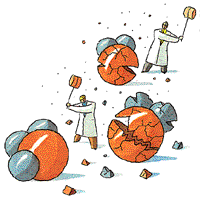Conversion: Cracking and rearranging molecules
Conversion is where fractions from the distillation towers are transformed intostreams (intermediate components) that eventually become finished products. This also is where a refinery makes money, because only through conversion can most low-value fractions become gasoline.
 The most widely used conversion method is called cracking, which uses heat and pressure to literally "crack" heavy hydrocarbon molecules into lighter ones. A cracking unit consists of one or more tall, thick-walled, bullet-shaped containers, called reactors, and a network of furnaces, heat exchangers, and other vessels.
The most widely used conversion method is called cracking, which uses heat and pressure to literally "crack" heavy hydrocarbon molecules into lighter ones. A cracking unit consists of one or more tall, thick-walled, bullet-shaped containers, called reactors, and a network of furnaces, heat exchangers, and other vessels.
Fluid catalytic cracking, or "cat cracking," is the basic gasoline-making process. Using intense heat (about 1,000 degrees Fahrenheit), low pressure and a powdered catalyst (a substance that accelerates chemical reactions), the cat cracker can convert most relatively heavy fractions into smaller gasoline molecules.
Hydrocracking applies the same principles but uses a different catalyst, slightly lower temperatures, much greater pressure and hydrogen to obtain chemical reactions. Although not all refineries employ hydrocracking, Chevron is an industry leader in using this technology to cost-effectively convert medium- to heavyweight gas oils into high-value streams. The company's patented hydrocracking process, which takes place in theIsocracker unit, produces mostly gasoline and jet fuel.
Some refineries also have cokers, which use heat and moderate pressure to turn residuum into lighter products and a hard, coallike substance that is used as an industrial fuel. Cokers are among the more peculiar-looking refinery structures. They resemble a series of giant drums with metal derricks on top.
Cracking and coking are not the only forms of conversion. Other refinery processes, instead of splitting molecules, rearrange them to add value. Alkylation, for example, makes gasoline components by combining some of the gaseous byproducts of cracking. The process, which essentially is cracking in reverse, takes place in a series of large, horizontal vessels and tall, skinny towers that loom above other refinery structures.
Reforming uses heat, moderate pressure, and catalysts to turn naphtha, a light, relatively low-value fraction of the oil, into high-octane gasoline.
No comments:
Post a Comment